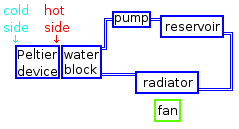Regular_Peltier_cooling_setup_for_PC.png (239 × 129 pixels, file size: 5 KB, MIME type: image/png)
Summary
Schematic of how a Peltier element is generally used for cooling PC components (such as CPU's, ...). The Peltier element is placed directly on top of the hardware to be cooled, and the coolant is used to conduct the heat away from the hot side of the Peltier element).[1]Note that it is also possible to use the Peltier device to cool the radiator in a regular liquid cooling setup for PC's, but this setup shown here is more common.
The main advantage of the shown setup is that it allows to cool the computer component better (to much lower temperatures than what would be possible using a regular liquid cooling setup).
The disadvantage however is that the Peltier element -trough its cooling action- can cause the surrounding air to condense, and this condensation (water) can cause problems on the printed circuit board.[2]
Another disadvantage is that since the radiator still needs to be cooled (and since this is often done using a fan instead of an extra Peltier element -another Peltier element would again increase energy use a lot; since they're much less energy efficient than fans-), the setup is still not very quiet, despite allready using a Peltier element to help with the cooling.
References Template:Reflist
Licensing
File history
Click on a date/time to view the file as it appeared at that time.
| Date/Time | Thumbnail | Dimensions | User | Comment | |
|---|---|---|---|---|---|
| current | 14:37, 26 July 2014 |  | 239 × 129 (5 KB) | KVDP (talk | contribs) | Schematic of how a Peltier element is generally used for cooling PC components (such as CPU's, ...). The Peltier element is placed directly on top of the hardware to be cooled, and the coolant is used to conduct the heat away from the hot side of the P... |
You cannot overwrite this file.
File usage
The following file is a duplicate of this file (more details):
- File:Regular Peltier cooling setup for PC.png from Wikimedia Commons
There are no pages that use this file.
